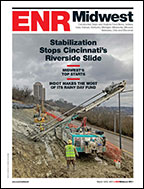...the level of shaking is quite severe,“ says John Wilson, chair of the Australian Earthquake Loading Standard and deputy dean of engineering at Swinburne University of Technology, speaking on behalf of the Australian Science Media Centre (AusSMC). ”In general the contemporary buildings performed well, although a few contemporary buildings have collapsed, which did surprise us.“
New Zealand building codes are comparable to those in the U.S. and Japan, explains Gilani. ”Based on what we have seen,“ he says, ”it will take many months, even years to repair the damage and rebuild to a much higher standard.
”And because the New Zealand islands straddle a geologically unstable area, known as the Ring of Fire, serious aftershocks and future events cannot be ruled out,“ adds Gilani.
H. Kit Miyamoto, Miyamoto�s chief executive, is in Haiti and he compared the Haiti and New Zealand quakes in statements released by his firm.
”In Haiti, where Miyamoto teams have been working for the last year to assess the damage and restore and rebuild housing, we have seen the worst of what earthquakes can cause,“ he says. ”But the collapse ratio in some of areas of New Zealand is reaching a similar percentage as in Haiti.
”We have also learned from our experience in responding to earthquake events around the world about what should be done to prevent this kind of devastation. We hope to lend our expertise to the city of Christchurch to build in a manner that will prevent this loss of human life and extensive economic dislocation in the future,“ Miyamoto says.
The New Zealand Building Code can be viewed on-line. In particular clause B1 Structure covers seismic resistance, says the AusSMC. Limit state design methods have supplanted working stress methods for habitable buildings. All of the loading codes define seismic hazard zones on maps that have changed over the years.
Since the mid-70s, buildings have been well-designed for earthquake resistance, says Wilson.
Most Buildings Fared Well
”What�s more, the standard of design has still been improving over the last 20 years or so, which is why most buildings performed well, with the exception of a few buildings that were severely damaged or partially collapsed,“ he adds.
Melissa Giovanni, a professor of geology at the University of Calgary, Alberta, Canada, has her own theories about the damage. She blames much of it on the Sept. 4 quake.
”New Zealand is a first-world country, and the reason the damage is so much greater is that it�s an aftershock of the larger magnitude-7.1 earthquake that happened,“ she says.
Giovanni speculates that many buildings were already weakened by the Sept. 4 event, so much that the magnitude-6.3 temblor would be much more devastating. ”Another reason this earthquake was more damaging is that it was closer to the surface, and so the movement would be more intense than in a deeper quake where the earth can dissipate some of the energy,“ says Giovanni.
In New Zealand, the North Island is located where two plates are converging—the Australian Plate and the Pacific Plate. On South Island, the plates are sliding past each other in what is known as a strike-slip fault, called the Alpine Fault.
The fault is similar to the San Andreas Fault in California, says Giovanni. "These plates are always in motion,“ she adds.
The grinding and scraping of the plates against each other breaks rocks and causes earthquakes. The crust is still trying to regain its equilibrium since the Sept. 4 quake, says Giovanni.
She calls the fault that broke an oblique thrust, which means there was some horizontal movement and some vertical movement. ”So the initial movement probably felt like a lift as the earth moved vertically, and then later you would feel vertical and horizontal movement," says Giovanni.
Aftershocks have been common since September, with several having magnitudes larger than 5.0. ”We can expect aftershocks to continue for days, weeks and months,“ says Giovanni.
To help with rescue and recovery, at the request of the New Zealand government, the U.S. is deploying a U.S. Agency for International Development (USAID) Disaster Assistance Response Team (DART). The team will include the Los Angeles County Fire Dept.�s Urban Search and Rescue team (USAR) to assist with the search and rescue efforts.
The USAR component of the DART will be what is called a ”heavy team,“ bringing more than 70 specialized personnel and all necessary equipment to make live rescues in even the most precarious situations, according to USAID.



Post a comment to this article
Report Abusive Comment